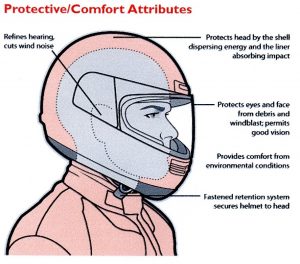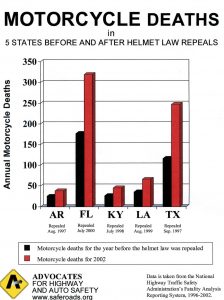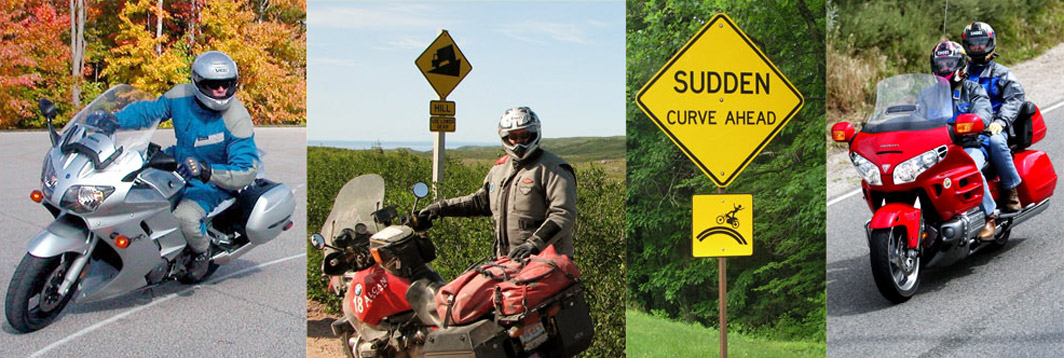Educational Materials
The material in this section is designed for easy access, downloading and use for distribution to others. There is a summary of countermeasure research, motorcycle helmet information including the common myths, information about the impact of helmet laws or the repeal of such laws and a section regarding full protective gear. In addition to this section there is also great material for distribution or use in presentations posted in the drop-down menu under GEAR, and IDEAS & OPINIONS and PLANS & PROPOSALS in the drop-down menu under INFORMATION. SMARTER is Michigan based so we have have a section related to our home state. Contact us at smarterusa@gmail.com if you don’t find what you are searching for.
Data, facts and statistics
National Center for Statistics and Analysis (NCSA) FARS and GES/CRSS query reporting tools and traffic safety publications Select from the nine choices in Tools, Publications and Data. We especially recommend the Motorcycle Data Visualization Tool.
Want data, facts and statistics? Visit the National Motorcycle Institute Fatality Reporting System site
2023 – Motorcycle Helmet Use in 2022. NHTSA Traffic Safety Facts – Research Note, DOT HS 813 505, August 2023.
Fatality Facts 2018 Motorcycles and ATVs. Insurance Institute for Highway Safety (IIHS)/The Highway Loss Data Institute (HLDI). The facts are based on analysis of data from the U.S. Department of Transportation’s Fatality Analysis Reporting System (FARS). December 2019.
2022 – Estimating Motorcycle Miles Traveled From State Vehicle Inspection Records
2021 – Meth0dologies for Estimating Motorcycle VMT
Motorcycles Registered in the US: 2002 – 2023 This report from the Insurance Institute for Highway Safety provides charts for the number of on-road motorcycles registered by state for each year 2002-2023.
2022 – Motorcycle Helmet Use in 2021 – Overall Results NHTSA Fact Sheet, March, 2022
Motorcyclist Traffic Safety Facts 2022 Data – NHTSA report published July 2024
2021 Motorcyclist Traffic Safety Facts– NHTSA report published June 2023
2020 Motorcyclist Traffic Safety Fact Sheet – NHTSA report published May 2022
2019 Motorcyclist Traffic Safety Fact Sheet – NHTSA report published September 2021
2018 State Operator Licensing Data and Information
2018 Motorcyclist Traffic Safety Fact Sheet – NHTSA report published November 2020
2017 Motorcyclist Traffic Safety Fact Sheet – NHTSA report published August 2019
2016 Motorcyclist Traffic Safety Fact Sheet – NHTSA report published February 2018
Michigan Specific Data
Estimated Lives Lost by Unhelmeted Riders – Michigan – 2012 – 2023
Ten Year Post Motorcycle Helmet Law Repeal: Michigan Summary. 2012-2021
Michigan Motorcyclist Crash and Fatality Data and Charts – Fatalities 1992-2021, Crashes 2007-2021, Registrations 2007-2021, Fatality rates 2007=2021, Data comparisons for prior to and post helmet law change in 2012.
Motorcycle-Involved Crashes in Michigan – 2018-2022
Motorcycle-Involved Crashes in Michigan – 2017-2021
Motorcycle-Involved Crashes in Michigan – 2015-2019
2009 – 2018 Motorcycle Helmet Traffic Crash Statistics – Michigan
2014 – 2023 Michigan Motorcycle Helmet Traffic Crash Statistics
Countermeasures
Countermeasures that Work – Special Edition of Riding Smart: What the Research Tells Us: This Jan./Feb. 2018 Special Edition of Riding Smart summarizes the major research and literature reviews which address countermeasures in motorcyclist safety. Countermeasures are the things we do to try to reach our goals. Interventions, efforts and program components are other descriptive terms describing what we do. A main mission of SMARTER is to gather and make motorcyclist safety research easily accessible. This special issue is designed to provide a quick reference summary of the research regarding countermeasures that work (or have no evidence of working).
Protective Gear
Protective Gear Brochure This is a 2023 Michigan Office of Highway Safety Planning brochure the content of which was written/developed by SMARTER – makes an excellent handout.
Neck Injury, Neck Pain & Preventative Measures: This is an October/September 2018 special edition of Riding Smart, the member newsletter of SMARTER. The research regarding helmets and neck injury is reviewed, the issue of neck pain and wearing a helmet is addressed and injury and pain preventative measures are discussed.
Riding SMART! (Sept/Oct 2014): A downloadable special edition of SMARTER’s newsletter is a quick reference that (1) summarizes quality research and/or literature reviews related to helmet use and helmet-use laws, (2) provides a brief history of helmet use and helmet-use laws, and (3) reviews the components and goals of a comprehensive motorcyclist-safety program.
 Research Reference List: Motorcycle Helmets and Helmet Laws: Studies show helmets save lives and reduce injuries and that all-rider helmet laws are a scientifically proven lifesaving intervention. SMARTER has compiled a Research Reference List regarding motorcycle and motorcycle helmet law effectiveness including economic impacts.
Research Reference List: Motorcycle Helmets and Helmet Laws: Studies show helmets save lives and reduce injuries and that all-rider helmet laws are a scientifically proven lifesaving intervention. SMARTER has compiled a Research Reference List regarding motorcycle and motorcycle helmet law effectiveness including economic impacts.
Debunking Common Claims Against Motorcycle Helmets and All-Rider Helmet Laws: The truth about what you may have heard: Anti-helmet law advocates who want to repeal all rider helmet laws so that they can have the freedom to feel the wind in their hair have been known to “bend the truth” about helmets. In order to convince decision makers to repeal a lifesaving, injury reducing and cost preventing law, they haven’t been entirely truthful about the facts. Here are the FACTS.
What You Should Know About Motorcycle Helmets: The Motorcycle Safety Foundation, as part of its Cycle Safety Information series, produced this four-page document explaining the basic construction of a helmet, how helmets work, and how to choose one that fits.
Bogus Helmets: What You Know Could Save Your Life! – the Washington State Patrol, in cooperation with the Washington Traffic Safety Commission, produced this four-page helmet-shopping guide to explain the differences between real helmets that have been manufactured to meet DOT standards and fake, novelty-style helmets with thin shells.
Why Should You Wear a Full-face Helmet?: This “wear your helmet” poster prepared by Jeff Dean shows the helmet worn by Dave Swisher, a 1.1-million-mile BMW rider, after he suffered a crash, along with schematic diagrams of the impact areas on crash-involved motorcycle helmets.
Motorcycle Safety: How to Save Lives and Save Money: The Centers for  Disease Control and Prevention produced this 26-page guide to inform readers about the public health significance of motorcycle crashes, the best way protect riders (showing the anatomy of a helmet and what helmets do to prevent injuries), how states compare with one another in terms of motorcycle-related deaths and economic costs, and what can be done to increase motorcyclist safety.
Disease Control and Prevention produced this 26-page guide to inform readers about the public health significance of motorcycle crashes, the best way protect riders (showing the anatomy of a helmet and what helmets do to prevent injuries), how states compare with one another in terms of motorcycle-related deaths and economic costs, and what can be done to increase motorcyclist safety.
Motorcycle Helmet Laws
Without Motorcycle Helmets We All Pay the Price Tri-fold color brochure fits a 6 x 9 envelope. This brochure presents the case for helmet use and all-rider helmet laws. Motorcycle helmet laws prevent deaths, prevent injuries and lower injury severity and reduce costs to society. We can provide these in limited quantities and will provide a print ready copy for you to do your own printing. Contact us at smarterusa@gmail.com.
Top Reasons Why Every State Should Pass an All-Rider Motorcycle Helmet Law: This one-page document by Advocates for Highway and Auto Safety succinctly delineates seven reasons in support of mandatory helmet laws.
All-Rider Motorcycle Helmet Laws Save Lives and Tax Dollars: A rider’s personal choice stops being personal when it ends up costing us all. This one-page document by Advocates for Highway and Auto Safety reveals why repealing all-rider helmet laws is bad fiscal policy.
Universal Helmet Laws Reduce Injuries and Save Lives: This 14-page document resulted from a UCLA School of Public Health, Center for Injury Prevention, study that showed that a universal motorcycle helmet law is an effective and efficient traffic safety law that benefits society and individuals.
 Motorcycle Helmets and Helmet Use Laws: Research Facts Every Rider and Legislator Needs to Know. This six-page Q&A document by the Insurance Institute for Highway Safety addresses 12 common concerns about helmet use and helmet laws and provides 30 reference citations.
Motorcycle Helmets and Helmet Use Laws: Research Facts Every Rider and Legislator Needs to Know. This six-page Q&A document by the Insurance Institute for Highway Safety addresses 12 common concerns about helmet use and helmet laws and provides 30 reference citations.
Motorcycle Deaths in Five States Before and After Helmet Law Repeals: This chart by Advocates for Highway and Auto Safety is a graphic representation of the toll taken in lives lost after helmet law repeal in Arkansas, Florida, Kentucky, Louisiana, and Texas.
Full Protective Gear
Personal Protective Gear for the Motorcyclist: The Motorcycle Safety Foundation, as part of its Cycle Safety Information series, produced this four-page document describing all aspects of head-to-toe riding gear and protective apparel in varying weather conditions.
Protective Equipment for Riders: This 16-page booklet produced by the European Safer Urban Motorcycling (eSUM) Project offers clear guidelines on how to choose personal protective equipment and shows the evidence-based benefits of wearing jackets, trousers, footwear, gloves, and head and face protection.
Epic Journey: My Struggle to Ride by John Stockman. This story is not about an epic ride, rather it is the story of the immeasurable challenges John Stockman faced in order to ride. It is also the story of the sources of his strength, his realizations about the public perception of motorcycling and his resulting dedication to make a difference.
For Drivers and Driver Educators
For Car Drivers: A Program of the Motorcycle Safety Foundation: Link to a website with information about learning how to safely interact with motorcyclists from the people who know the challenges of motorcycling the best – the Motorcycle Safety Foundation.
For Car Drivers – Commitment-to-Safety Contract (MSF): A pledge for both new and experienced drivers to drive safely and to minimize risks and to lead by example, because family and friends are out there on the roadways – as drivers, motorcyclists, bicyclists, or pedestrians. From ForCarDrivers.com, a program of the Motorcycle Safety Foundation.
Ten Things All Car and Truck Drivers Should Know about Motorcycles – MSF: This information is from ForCarDrivers a Program of the Motorcycle Safety Foundation. We formatted it so drivers and driver educators could have a easily downloadable document.
How to Drive Safely Around Motorcycles by esurance: Five general rules to bear in mind when you share the road with motorcycles developed by esurance. We formatted their tips to provide drivers and driver educators with an easily downloadable document.
Driving Safely with Vulnerable Road Users in Mind: A document written specifically for student use during driver education courses. The four page document has four major sections (1) a general description of vulnerable road users and then a description of the three types of road users most often included in the general category (2) pedestrians (3) bicyclists and (4) motorcyclists. Tips for new drivers are included for each of the three types of vulnerable road users.
Looking Twice is not Enough: “Watch for Motorcycles, Look Twice, Save a Life” is the traditional reminder provided to car drivers during the month of May. “Look twice, save a life” is an easy to remember rhyming phrase which it tells drivers the end goal – save a life. However, to make that a reality car drivers need to know more and do more. This brief article describes the “how” of a search system designed to address the problems the research indicates are components of Looked But Failed to See crashes.
The Five Chances for Error The human eyes and brain are not the equivalent of the lens of a camera. The common sense argument that “if it is visible, we will see it if we look hard enough” simply isn’t true. This article describes the five chances for error and the visual phenomena associated with the Looked But Failed to See (LBFTS) Right-of-way Violation (ROWV) motorcyclist/car collision scenario. Recommended actions for both riders and drivers that will lessen the chance of these types of collision occurring are included.
SAR x 2= SSAARR: An Effective Traffic Search Procedure: Looked but Failed to See (LBFTS) intersection right-of-way (ROW) violations are caused by a combination of factors. Understanding the Four Chances for Error and the physiological phenomena associated with how our eyes and mind work to perceive provide the underpinning of the SMARTER developed contemporary driver search procedure SAR x 2 (SSAARR) – Stop fully, Search with specificity, Ask, Answer, Rock, and Roll forward slowly.
Lesson Plan Ideas: “Driving Safely with Vulnerable Road Users in Mind” and “Looking Twice is Not Enough” have been written specifically for student use during driver education courses. This document contains a few ideas for how driver educators might use this material and a True and False quiz for students.
Killer Pillars: An article describing an investigative report into a car design has reduced driver vision in its quest for five-star occupant safety ratings – creating a lethal danger to motorcyclists.
Looking for Motorcyclists: Videos for Drivers and Driver Educators
2022 – Inattentional Blindness video. This video was developed by the Michigan Department of State for driver education instructors for viewing by driver education students. The content of the video is based on a traffic search procedure developed by SMARTER which in turn is based on the perception research. The search procedure provides a specific process for looking for and identifying vulnerable road users specifically motorcyclists.
A Second Look: Created by the Washington Motorcycle Safety Program, follows a teen driver as a motorcyclist helps the driver learn about safer choices while sharing the road with motorcyclists.
How Close Does a Motorcyclists Have to Be?: A U.S. version of a popular U.K. safety video.
Minnesota Department of Public Safety motorcyclist awareness public service announcement encouraging motorists to “look twice” for riders.
Invisibility Training for Motorcyclist: This is an excellent video by FortNine which describes the visual and perception phenomena that result in motorcyclist not being seen by auto drivers and suggests five (5) actions riders can take to make themselves more likely to be seen. Important for drivers to understand why they sometimes look but fail to see oncoming motorcyclists.
Thank you drivers, we appreciate you!: Motorcycle safety requires not only riders but drivers to take extra precautions on the road. Developed by the Washington State Motorcyclist Safety Program.
Powerful Distracted Driving Videos: The Jacy Good story is powerful. There are a number of YouTube videos. Here are links to just two.
https://youtu.be/E9swS1Vl6Ok https://youtu.be/P54ln1139JM

